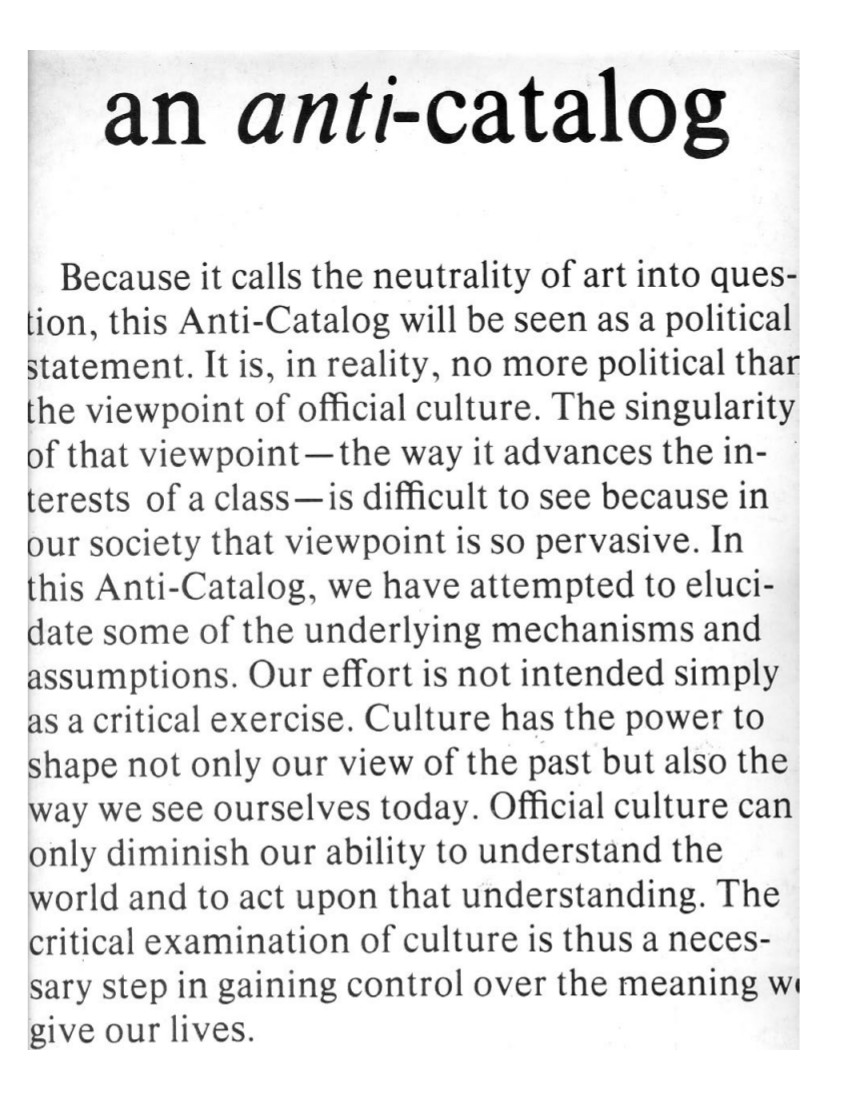an anti-catalog (1977)
Filed under catalogue | Tags: · activism, art, politics

“An Anti-Catalog was the work of the Catalog Committee of the group Artists Meeting for Cultural Change (AMCC). A landmark publication of the 1970s, its purpose was to protest the Whitney Museum of American Art’s bicentennial exhibition, which was titled Three Centuries of American Art. The Whitney show featured John D. Rockefeller III’s collection of mainly eighteenth and nineteenth-century American art–a collection that featured only one African American and one woman artist.
The Catalog Committee, which consisted of fifteen artists and two art historians, spent almost a year producing an eighty-page book containing articles and documents. Originally conceived as a critique of art historian E.P. Richardson’s catalog for the Whitney exhibition, the committee evolved ideas for pictorial essays that would encompass native American art, African-American art, art by women, critiques of pervasive class bias in the art world, and critical examinations of cultural institutions. As the committee wrote in its description of its project, ‘we share the belief that culture should no longer exist merely as an extension of the economic interests or the personal ‘tastes’ of the wealthy and powerful. Nor can we hope to transform culture outside of a struggle to transform the society from which it springs.’ Strong words that have lost little of their relevance for today’s cultural scene.” (Alan Wallach)
Written, designed, and produced by Rudolf Baranik, Sarina Bromberg, Sarah Charlesworth, Susanne Cohn, Carol Duncan, Shawn Gargagliano, Eunice Golden, Janet Koenig, Joseph Kosuth, Anthony McCall, Paul Pechter, Elaine Bendock Pelosini, Aaron Roseman, Larry Rosing, Ann Marie Rousseau, Alan Wallach, Walter Weissman.
Publisher Artists Meeting for Cultural Change, New York, 1977
80 pages
via Dark Matter Archives, via Primary Information
BAVO (eds.): Cultural Activism Today: The Art of Over-Identification (2007)
Filed under book | Tags: · activism, aesthetics, art, contemporary art

“Contemporary art seems to be caught in the blackmail typical for this self-acclaimed age of the End of History. On the one hand, the artist is elevated into ‘the One’ who relentlessly confronts society with its shortcomings and uses his creative intelligence to dream up new ideals. At the same time however, s/he is constantly reminded that this critical and utopian activity should remain ‘constructive’ – a coded way of saying that it should not fundamentally question the triumphant onward march of representative democracy and the free market. No wonder that art today threatens to be reduced to a purely empty exercise that, as Fukuyama claims, offers the last men an escape from their petty bourgeois existence.
The central question of Cultural Activism Today. The Art of Over-Identification is whether, and how, art can escape this suffocating situation. This volume argues that the key to a way out of the trap of the End of History lies in the strategy of over-identification. Instead of succumbing to society’s pathetic demand for small creative acts, artists should over-identify with the ruling, post-historical order and take the latter’s immanent laws to their most extreme, dystopian consequences.
By ruthlessly closing off any space for creative, utopian thinking – which today is nothing but a farce anyway – it should confront society with its own closure. This strategy of over-identification is assessed in essays by Boris Groys, Alexei Monroe, Dieter Lesage, Benda Hofmeyr and BAVO.”
Publisher episode publishers, Rotterdam, 2007
ISBN 9059730615, 9789059730618
119 pages
Review (Eva Fotiadi, OPEN)
PDF (no OCR, updated on 2024-2-19)
Comment (0)Tatiana Bazzichelli, Geoff Cox (eds.): Disrupting Business: Art & Activism in Times of Financial Crisis (2013)
Filed under book | Tags: · activism, art, financial crisis, media activism

“Disrupting Business explores some of the interconnections between art, activism and the business concept of disruptive innovation. With a backdrop of the crisis in financial capitalism and austerity cuts in the cultural sphere, the idea is to focus on potential art strategies in relation to a broken economy. In a perverse way, we ask whether this presents new opportunities for cultural producers to achieve more autonomy over their production process. If it is indeed possible, or desirable, what alternative business models emerge? This book is concerned broadly with business as material for reinvention, including critical writing and examples of art/activist projects.”
Contributors include Saul Albert, Christian Ulrik Andersen, Franco “Bifo” Berardi, Heath Bunting, Paolo Cirio, Baruch Gottlieb, Brian Holmes, Geert Lovink, Dmytri Kleiner, Georgios Papadopolous, Søren Bro Pold, Oliver Ressler, Kate Rich, René Ridgway, Guido Segni, Stevphen Shukaitis, Nathaniel Tkacz, and Marina Vishmidt.
Publisher Autonomedia, New York, October 2013
Data Browser series, 5
Creative Commons BY-NC-SA 3.0 Unported License
ISBN 9781570272646
232 pages

